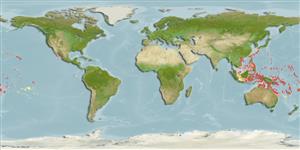>
Eupercaria/misc (Various families in series Eupercaria) >
Labridae (Wrasses) > Cheilininae
Etymology: Oxycheilinus: Greek, oxys = sharp + Greek, cheilos = lip; nigromarginatus: Name from the Latin, meaning black-margined, referring to the conspicuous black posterior margin on the caudal fin, the only obvious color marking persisting in preservative..
More on authors: Randall, Westneat & Gomon.
Environment: milieu / climate zone / depth range / distribution range
Écologie
marin récifal; profondeur 10 - 27 m (Ref. 56651). Subtropical
Southwest Pacific: from New South Wales, Chesterfield Bank in the Coral Sea, New Caledonia and Tonga.
Taille / Poids / Âge
Maturity: Lm ? range ? - ? cm
Max length : 11.3 cm SL mâle / non sexé; (Ref. 56651); 8.2 cm SL (female)
Description synthétique
Morphologie | Morphométrie
Épines dorsales (Total): 9; Rayons mous dorsaux (Total): 10; Épines anales 3; Rayons mous anaux: 8; Vertèbres: 23. This species is distinguished by the following characters: Dorsal rays IX, 10; anal rays III, 8; pectoral rays 13; lateral-line interrupted, with pored scales to caudal-fin base 15 + 6; gill rakers 5-6 + 8-9; body moderately elongate, depth 3.1-3.55 in SL; head length 2.45-2.55 in SL; snout long and pointed, 2.6-2.8 in head; dorsal profile of snout straight or with a slight concavity of snout to above eye; lower jaw is slightly projecting; maxilla reaching or nearly reaching a vertical at anterior margin of orbit; caudal fin of females slightly rounded, the upper 3 principal rays slightly prolonged; fin of males rhomboid with the upper 3 rays more strongly projecting; pectoral fins 2.6-2.95 in head; body and fins pale yellowish when preserved, with a blackish posterior margin on caudal fin, broader and black in male; first interspinous membrane of dorsal fin dusky; red in life on about upper half of body with 5 irregular pale bars, pale red on lower half with 3 pale stripes containing small white spots; posterior edge of caudal fin blackish to black (Ref. 56651).
Collected in protected waters of lagoons or harbors on mixed sand and coral-reef habitats (Ref. 56651).
Life cycle and mating behavior
Maturité | Reproduction | Frai | Œufs | Fécondité | Larves
Oviparous, distinct pairing during breeding (Ref. 205).
Randall, J.E., M.W. Westneat and M.F. Gomon, 2003. Two new labrid fishes of the genus Oxycheilinus from the South Pacific. Proc. Calif. Acad. Sci. 54(20):361-370. (Ref. 56651)
Statut dans la liste rouge de l'IUCN (Ref. 130435)
Menace pour l'homme
Harmless
Utilisations par l'homme
Plus d'informations
Taille/ÂgeCroissanceLongueur-poidsLongueur-longueurFréquences de longueursMorphométrieMorphologieLarvesDynamique des populations larvairesRecrutementAbondanceBRUVS
RéférencesAquacultureProfil d'aquacultureSouchesGénétiqueElectrophoresesHéritabilitéPathologiesTraitementNutrientsMass conversion
CollaborateursImagesStamps, Coins Misc.SonsCiguateraVitesseType de nageSurface branchialeOtolithesCerveauxVision
Outils
Articles particuliers
Télécharger en XML
Sources Internet
Estimates based on models
Preferred temperature (Ref.
123201): 25 - 28.2, mean 26.5 °C (based on 239 cells).
Phylogenetic diversity index (Ref.
82804): PD
50 = 0.5020 [Uniqueness, from 0.5 = low to 2.0 = high].
Bayesian length-weight: a=0.01585 (0.00707 - 0.03555), b=2.95 (2.76 - 3.14), in cm total length, based on LWR estimates for this (Sub)family-body shape (Ref.
93245).
Niveau trophique (Ref.
69278): 3.7 ±0.6 se; based on size and trophs of closest relatives
Résilience (Ref.
120179): Haut, temps minimum de doublement de population inférieur à 15 mois (Preliminary K or Fecundity.).
Fishing Vulnerability (Ref.
59153): Low vulnerability (10 of 100).
